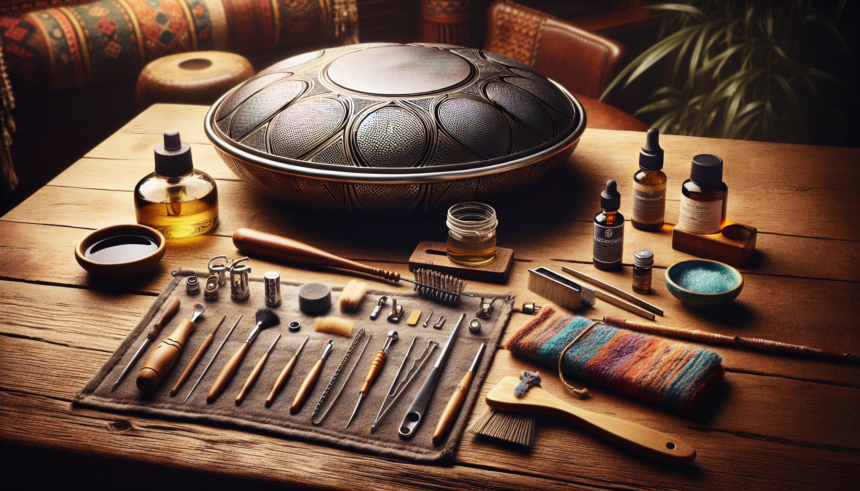<!DOCTYPE html>
<html lang="en">
<head>
<meta charset="UTF-8">
<meta name="viewport" content="width=device-width, initial-scale=1.0">
<title>Handpan Maintenance Kit Guide</title>
<style>
body {
font-family: Arial, sans-serif;
line-height: 1.6;
margin: 20px;
color: #333;
}
h1, h2, h3, h4 {
color: #2c3e50;
}
h1 {
text-align: center;
}
.faq {
margin-top: 40px;
}
.faq h3 {
margin-top: 20px;
}
</style>
</head>
<body>
<h1>Expert Tips on Assembling Your Handpan Maintenance Kit</h1>
<p>
The handpan is a remarkable musical instrument cherished for its ethereal sound and captivating appearance. Owners of these unique instruments understand the importance of maintenance to preserve their beauty and functionality. By assembling a dedicated handpan maintenance kit, enthusiasts can ensure that their instruments remain in top condition, offering expressive tones and vibrant acoustics for years to come. This guide offers expert insights into assembling your handpan maintenance kit effectively and addresses common questions on the subject.
</p>
<h2>Understanding the Basics of Handpan Maintenance</h2>
<p>
Before delving into the specifics of assembling a handpan maintenance kit, it’s important to understand the primary components and factors that affect handpan care. Handpans are generally made of steel and require maintenance to prevent rust and wear. These instruments must be kept clean and protected from moisture, extreme temperatures, and physical damage.
</p>
<p>
Proper maintenance involves regular cleaning, lubrication, and protective storage. Each of these aspects can be handled efficiently with the right tools and supplies, transpiring the need for a comprehensive maintenance kit.
</p>
<h2>Essential Components of a Handpan Maintenance Kit</h2>
<h3>1. Cleaning Cloths and Brushes</h3>
<p>
High-quality microfiber cloths are vital for removing dirt, dust, and fingerprints from the surface of your handpan without scratching it. Additionally, soft-bristle brushes can be useful for cleaning more persistent debris in hard-to-reach areas. Ensure these cleaning tools are free from any abrasive materials.
</p>
<h3>2. Rust Inhibitor</h3>
<p>
Rust is a major threat to handpans due to their metallic composition. Using a non-abrasive rust inhibitor designed specifically for steel instruments can help to protect your handpan from rust and corrosion. Apply it according to the manufacturer’s instructions to ensure effective coverage and protection.
</p>
<h3>3. Oil or Wax</h3>
<p>
Regularly applying a suitable oil or wax is essential to maintain the finish of your handpan. This helps to create a barrier against moisture and enhances the instrument’s aesthetics. Look for oils or waxes that are specifically formulated for metallic surfaces, ensuring they do not leave a sticky residue.
</p>
<h3>4. Gloves</h3>
<p>
Wearing gloves while handling your handpan during the maintenance process can prevent fingerprints and oils from your hands transferring onto the metal surface. This is particularly important after cleaning and oiling the handpan to avoid undoing your hard work.
</p>
<h3>5. Humidity Monitor and Control</h3>
<p>
Measuring and controlling the humidity where your handpan is stored is critical. Extreme humidity levels can lead to rust and damage. A small, portable hygrometer can help monitor these levels, while silica gel packets or dehumidifiers can effectively manage the environment to keep your handpan safe.
</p>
<h2>Additional Tools for Advanced Maintenance</h2>
<h3>1. Tuning Hammer and Tools</h3>
<p>
While tuning a handpan is complex and typically requires professional assistance, having a basic understanding and the right tools can be beneficial for minor adjustments. If you decide to include these in your maintenance kit, ensure you are adequately trained to use them without risking damage to your instrument.
</p>
<h3>2. Carrying Case</h3>
<p>
A durable and padded carrying case is crucial for protecting your handpan during transportation. This helps safeguard against physical impacts that might lead to dents or other damage. Look for cases that offer a snug fit and robust material to ensure utmost protection.
</p>
<h3>3. Record Log</h3>
<p>
Keeping a detailed log of your handpan’s maintenance routine can be incredibly beneficial. Note the date of each cleaning, oiling, and any repairs or modifications done. This can help identify patterns and ensure that your instrument’s upkeep is timely.
</p>
<h2>Expert Tips for Effective Handpan Maintenance</h2>
<h3>Regular Schedule</h3>
<p>
Establishing a regular maintenance schedule is essential. Depending on the frequency of use and environmental factors, cleaning, oiling, and checking for rust should be done at intervals that suit your specific handpan. Typically, a monthly routine is effective, but this can vary.
</p>
<h3>Environmental Considerations</h3>
<p>
Always store your handpan in a controlled environment. Avoid exposure to extreme temperatures or direct sunlight. Make use of your humidity monitor to keep conditions ideal, particularly during seasonal changes.
</p>
<h3>Transport Carefully</h3>
<p>
When transporting your handpan, use a high-quality carrying case and handle with care. Avoid stacking heavy items on top of it and ensure it’s secure during transit. Your maintenance kit should also be portable in case the need arises to clean or inspect your handpan on the go.
</p>
<h3>Professional Inspections</h3>
<p>
Despite regular home maintenance, consulting with a handpan professional annually can be beneficial. They can assess elements beyond typical at-home care such as subtle tuning needs and deep cleaning.
</p>
<h3>Education and Community</h3>
<p>
Engage with the handpan community to stay updated on new maintenance techniques and products. Workshops, online forums, and local meetups can be invaluable resources for continuing education on your instrument's care.
</p>
<h2>Conclusion</h2>
<p>
Assembling a handpan maintenance kit involves a conscious effort to understand the needs of your instrument, backed by a mix of essential tools and good practices. By dedicating time to its upkeep, you not only extend the lifespan of your handpan but also preserve its acoustic beauty. Let this guide be a stepping stone towards a well-maintained instrument, ensuring that your handpan continues to produce the mesmerizing sounds you cherish.
</p>
<div class="faq">
<h2>FAQs</h2>
<h3>1. How often should I clean my handpan?</h3>
<p>
It’s recommended to clean your handpan monthly or after every few sessions of use, especially if played outdoors. More frequent cleaning might be necessary depending on the playing environment and humidity levels.
</p>
<h3>2. Can I use any oil for handpan maintenance?</h3>
<p>
No, always use oils formulated for metallic instruments. These are designed to protect without leaving residue and won’t damage the surface or affect the handpan’s sound.
</p>
<h3>3. How can I prevent my handpan from rusting?</h3>
<p>
Use a rust inhibitor, store your handpan in a dry and controlled environment, and ensure regular cleaning and oiling. Monitoring humidity levels in the storage area is crucial to prevent rust.
</p>
<h3>4. Is it necessary to wear gloves while maintaining my handpan?</h3>
<p>
Wearing gloves is highly recommended to prevent transferring oils and dirt from your hands onto the handpan’s surface after cleaning and oiling, which could lead to smudges or corrosion.
</p>
<h3>5. Should I tune my handpan myself?</h3>
<p>
Tuning a handpan is intricate and generally best left to professionals. However, understanding minor adjustments can be beneficial if you have the right tools and training. For significant tuning needs, consult a professional.
</p>
</div>
</body>
</html>Expert Tips on Assembling Your Handpan Maintenance Kit

Leave a comment




